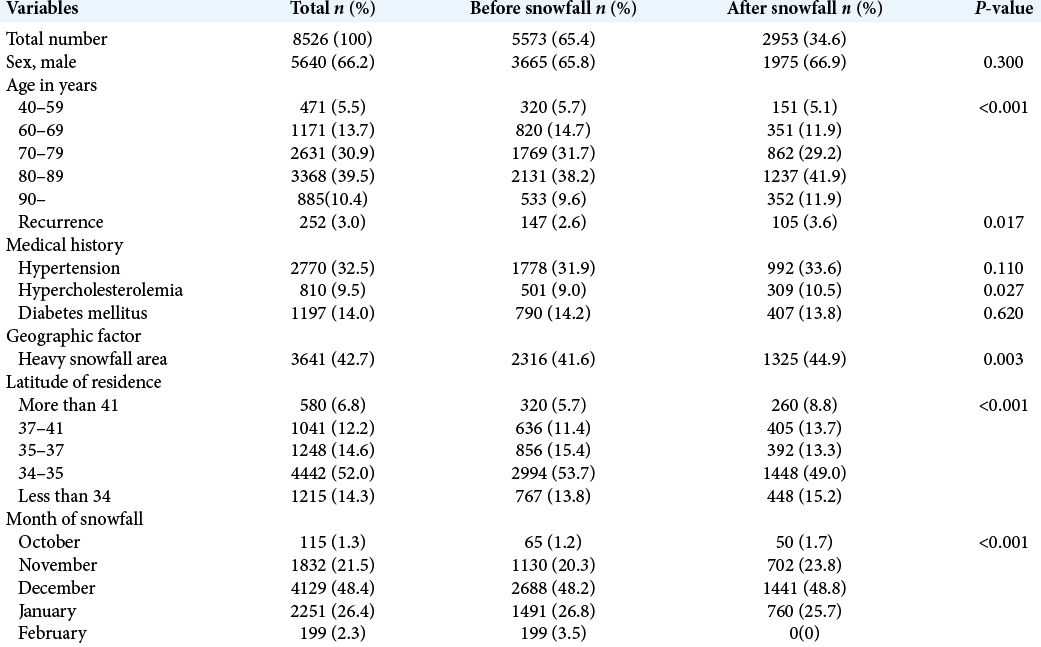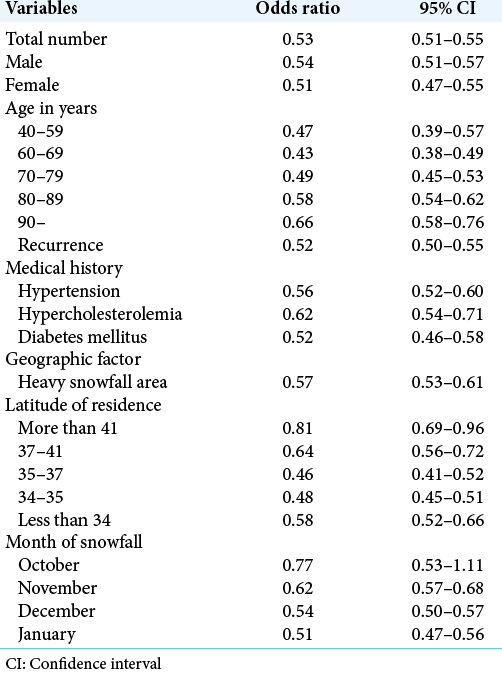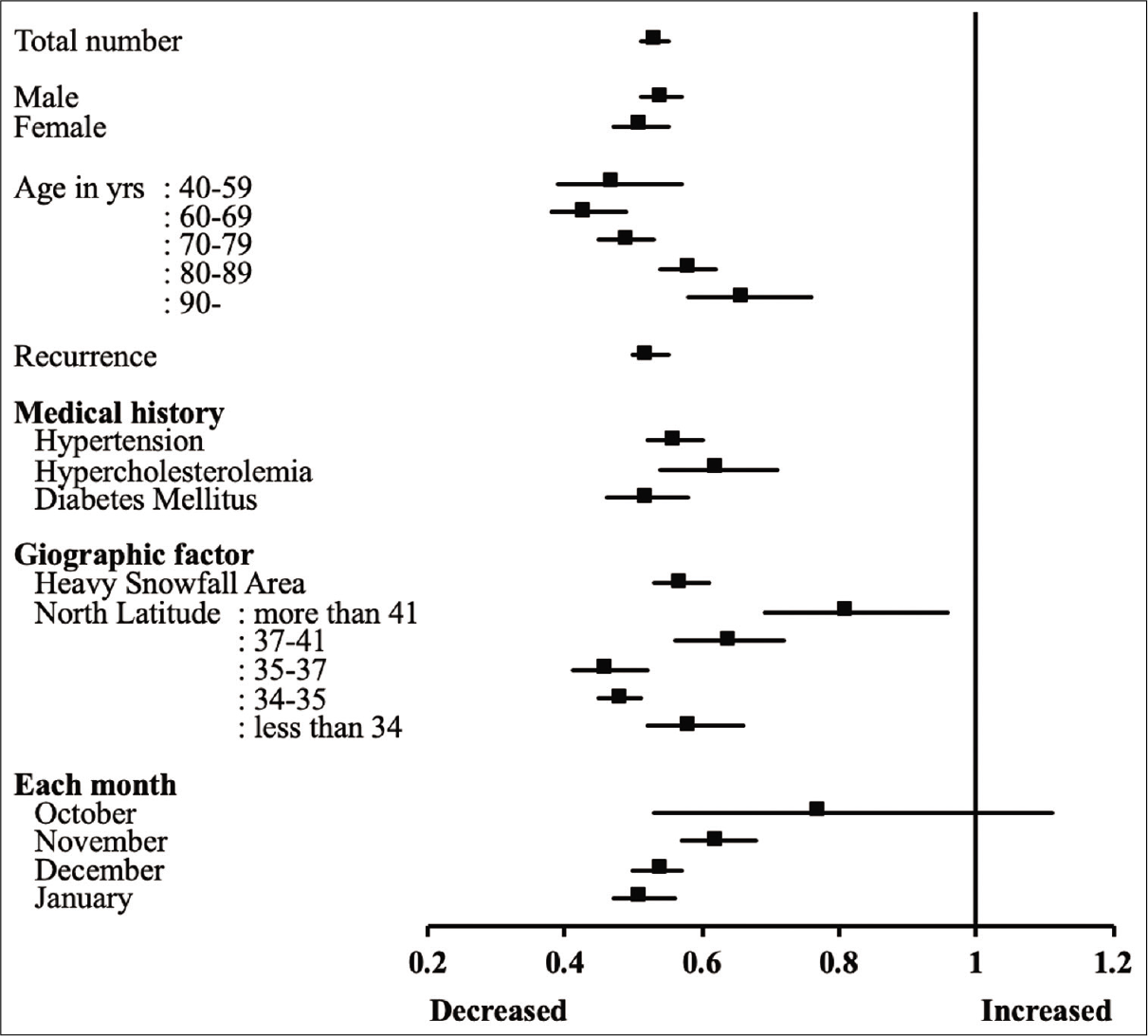- Department of Neurological Surgery, Nippon Medical School, Bunkyo-ku, Japan.
- Department of Clinical Epidemiology and Health Economics, School of Public Health, The University of Tokyo, Japan.
- Department of Anatomy and Neurobiology, Graduate School of Medicine, Nippon Medical School, Tokyo, Japan.
- Department of Neurosurgery for Community Health, Nippon Medical School, Tokyo, Japan.
- Department of Health Policy and Informatics, Tokyo Medical and Dental University Graduate School of Medicine, Tokyo, Japan.
Correspondence Address:
Kazunori Oda
Department of Neurological Surgery, Nippon Medical School, Bunkyo-ku, Japan.
DOI:10.25259/SNI_882_2020
Copyright: © 2020 Surgical Neurology International This is an open-access article distributed under the terms of the Creative Commons Attribution-Non Commercial-Share Alike 4.0 License, which allows others to remix, tweak, and build upon the work non-commercially, as long as the author is credited and the new creations are licensed under the identical terms.How to cite this article: Kazunori Oda1, Shotaro Aso2, Yujiro Hattori1,3, Fumio Yamaguchi1,4, Hiroki Matsui2, Kiyohide Fushimi5, Hideo Yasunaga2, Akio Morita1. Snowfall reduces the risk of chronic subdural hematoma onset: Analysis of an administrative database in Japan. 23-Feb-2021;12:69
How to cite this URL: Kazunori Oda1, Shotaro Aso2, Yujiro Hattori1,3, Fumio Yamaguchi1,4, Hiroki Matsui2, Kiyohide Fushimi5, Hideo Yasunaga2, Akio Morita1. Snowfall reduces the risk of chronic subdural hematoma onset: Analysis of an administrative database in Japan. 23-Feb-2021;12:69. Available from: https://surgicalneurologyint.com/?post_type=surgicalint_articles&p=10604
Abstract
Background: Chronic subdural hematoma (CSDH) is a frequently observed disease in neurosurgical practice. Although first snowfall has been considered to increase the onset of CSDH, few reports have assessed the relationship between snowfall and CSDH. In this study, we aimed to investigate the relationship between CSDH onset and first snowfall events.
Methods: This retrospective study was based on the Japanese Diagnosis Procedure Combination inpatient database from July 1, 2010, to March 31, 2016, and on the global observation of snowfall events in Japan obtained from the Japan Meteorological Agency. We used a binomial approximation to evaluate the average number of CSDH patients after first snowfall events compared with that before first snowfall events. We calculated the odds ratio of CSDH onset on the first snowfall.
Results: We identified 8526 CSDH patients from the database. A total of 5573 (65.4%) were observed before first snowfall events, and 2953 (34.6%) after first snowfall events. The first snowfall of winter was significantly associated with a reduction in the occurrence of CSDH (odds ratio, 0.53; 95% confidence interval; 0.51–0.55). In subgroup analysis, only the first snowfall in October was not associated with reduction in the occurrence of CSDH.
Conclusion: First snowfall events did not affect the onset of CSDH in Japan.
Keywords: Chronic subdural hematoma, Epidemiology, Neurosurgery, Snowfall, Trauma
INTRODUCTION
Chronic subdural hematoma (CSDH) is defined as a collection of encapsulated liquefied hematoma in the subdural space after head trauma and may result in brain compression and subsequent neurological deficits.[
The aim of the present study was to investigate whether first snowfall increases the onset of CSDH using a Japanese nationwide administrative database.
MATERIALS AND METHODS
Data sources
Relevant data about CSDH were obtained from the Diagnosis Procedure Combination database. The database includes discharge abstracts and administrative claims from more than 1200 acute-care hospitals in Japan,[
Meteorological analysis
The data for the global observation of snowfall events in Japan were obtained from the Japan Meteorological Agency.[
Patient selection
We included patients who were diagnosed with traumatic subdural hematoma (ICD-10 codes: S65.0) or non-traumatic subdural hematoma (I62.0) from July 1, 2010 to March 31, 2016, and who were admitted between 2 weeks and 2 months before or after the 1st day of each snowfall event, because the time from head trauma to the onset of CSDH is typically more than 2 weeks.[
Patient characteristics and outcomes
Patient characteristics included sex, age, recurrence, hypertension, hypercholesterolemia, diabetes mellitus, residence in a heavy snowfall area, latitude of residence, and month of CSDH onset. Patients were divided into the following groups based on age: 40–59 years, 60–69, 70–79, 80–89, and 90 years and older. Recurrence was defined as re-admission with the same ICD-10 codes. Heavy snowfall areas were identified in certain prefectures as defined by the Japanese law, and specifically the Act on Special Measures concerning Countermeasures for Heavy Snowfall Areas (Act No. 73 of 1962).[
Patients’ settlement areas were divided based on the north latitude: lower than 34°, 34–35, 35–37, 37–41, and higher than 41°. The months of the 1st day of snowfall events were from October to February each year.
Ethical statement
The present study was approved by the Institutional Review Board of The University of Tokyo. Because of the anonymous nature of the data, the requirement for informed consent was waived.
Patient and public involvement
No real patient involved in this study.
Statistical analysis
We used a binomial approximation to evaluate the average number of cases in the before snowfall and after snowfall groups. This is essentially equivalent to examining the deviations of each group from a common ratio, since the patient database was large and odds ratio can be estimated by the ratio in each group. The main advantage of this approach is that it is simple to program, easy to repeat, and readily generates odds ratio measures of relative risk along with 95% confidence intervals (CI). The binomial approximation is sufficiently simple that it can be checked with a hand-held calculator.[
RESULTS
From July 1, 2010 to March 31, 2016, a total of 8,526 patients satisfied our selection criteria. Of them, 5573 (65.4%) were observed before snowfall events, and 2953 (34.6%) after snowfall events. [
DISCUSSION
This study investigated the effect of first snowfall on the onset of CSDH. We hypothesized that first snowfall events will increase CSDH onset; however, the results showed that first snowfall events were significantly associated with a reduction in the onset of CSDH.
This study aimed to examine whether snowfall could be a risk factor for the development of CSDH, and compared before and after the 1st day of snowfall during the snowfall season to eliminate confounding factors such as temperature, climate, and barometric pressure.
A previous study found that snowfall could be a risk factor for CSDH recurrence.[
A potential reason for CSDH onset not increasing at first snowfall events may be that patients tended to stay at home because snowfall affects traffic safety by causing changes in roadway surfaces and visibility, thus resulting in more frequent crashes, spinouts, and breakdowns.[
Subgroup analysis revealed that the first snowfall significantly reduced the occurrence of CSDH, except in October. These results may be explained by the fact that people did not tend to stay home because of milder temperatures in October.
Although our study represents a large-scale analysis of CSDH in Japan, a number of limitations deserve attention. First, the database does not include detailed clinical information such as symptoms, vital signs, laboratory data, and medication history before admission. The previous studies have suggested that anticoagulant and antiplatelet agents are associated with the onset of CSDH.[
CONCLUSION
The present study, using a national inpatient database in Japan, did not find that CSDH onset was significantly higher after first snowfall events.
Declaration of patient consent
Patient’s consent not required as patients identity is not disclosed or compromised.
Financial support and sponsorship
This work was supported by grants from the Ministry of Health, Labor and Welfare, Japan (grant number 19AA2007 and H30-Policy-Designated-004), and the Ministry of Education, Culture, Sports, Science and Technology, Japan (grant number 17H04141).
Conflicts of interest
There are no conflicts of interest.
References
1. Adachi H, Shirotani K, Taguchi R. A literature review on people’s daily activities and support needs in areas of heavy snowfall. NNCR. 2017. 3: 21-8
2. Adhiyaman V, Asghar M, Ganeshram KN, Bhowmick BK. Chronic subdural haematoma in the elderly. Postgrad Med J. 2002. 78: 71-5
3. Auger N, Potter BJ, Smargiassi A, Bilodeau-Bertrand M, Paris C, Kosatsky T. Association between quantity and duration of snowfall and risk of myocardial infarction. CMAJ. 2017. 189: E235-42
4. Bischoff-Ferrari HA, Orav JE, Barrett JA, Baron JA. Effect of seasonality and weather on fracture risk in individuals 65 years and older. Osteoporos Int. 2007. 18: 1225-33
5. Chen JC, Levy ML. Causes, epidemiology, and risk factors of chronic subdural hematoma. Neurosurg Clin N Am. 2000. 11: 399-406
6. Karibe H, Kameyama M, Kawase M, Hirano T, Kawaguchi T, Tominaga T. Epidemiology of chronic subdural hematomas. No Shinkei Geka. 2011. 39: 1149-53
7. Kwon TH, Park YK, Lim DJ, Cho TH, Chung YG, Chung HS. Chronic subdural hematoma: Evaluation of the clinical significance of postoperative drainage volume. J Neurosurg. 2000. 93: 796-9
8. Nathan S, Goodarzi Z, Jette N, Gallagher C, HolroydLeduc J. Anticoagulant and antiplatelet use in seniors with chronic subdural hematoma: Systematic review. Neurology. 2017. 88: 1889-93
9. Oda K, Yamaguchi F, Ozeki T, Yui K, Kubota A, Morita A. Influence of snowfalls as a factor for chronic subdural hematoma recurrence: Regional meteorological analyses. J Neurol Disord. 2018. 6: 388
10. Ohno K, Suzuki R, Masaoka H, Matsushima Y, Inaba Y, Monma S. Chronic subdural haematoma preceded by persistent traumatic subdural fluid collection. J Neurol Neurosurg Psychiatry. 1987. 50: 1694-7
11. Redelmeier DA, Yarnell CJ. Can tax deadlines cause fatal mistakes?. Chance. 2013. 26: 8-14
12. Rundgren M, Engström M. A thromboelastometric evaluation of the effects of hypothermia on the coagulation system. Anesth Analg. 2008. 107: 1465-8
13. Seeherman J, Liu Y. Effects of extraordinary snowfall on traffic safety. Accid Anal Prev. 2015. 81: 194-203
14. The Japan Metrological Agency. Available from: http://www.jma.go.jp/jma/indexe.html [Last accessed on 2019 Nov 01].
15. The Japanese Law Translation. Available from: http://www.japaneselawtranslation.go.jp [Last accessed on 2019 Nov 01].
16. Wada T, Yasunaga H, Horiguchi H, Matsubara T, Fushimi K, Nakajima S. Outcomes of argatroban treatment in patients with atherothrombotic stroke: Observational nationwide study in Japan. Stroke. 2016. 47: 471-6
17. Yamana H, Moriwaki M, Horiguchi H, Kodan M, Fushimi K, Yasunaga H. Validity of diagnoses, procedures, and laboratory data in Japanese administrative data. J Epidemiol. 2017. 27: 476-82
18. Yang W, Huang J. Chronic subdural hematoma: Epidemiology and natural history. Neurosurg Clin N Am. 2017. 28: 205-10
19. Yasunaga H, Matsui H, Horiguchi H, Fushimi K, Matsuda S. Clinical epidemiology and health services research using the diagnosis procedure combination database in Japan. Asian Pac J Dis Manag. 2015. 7: 19-24








